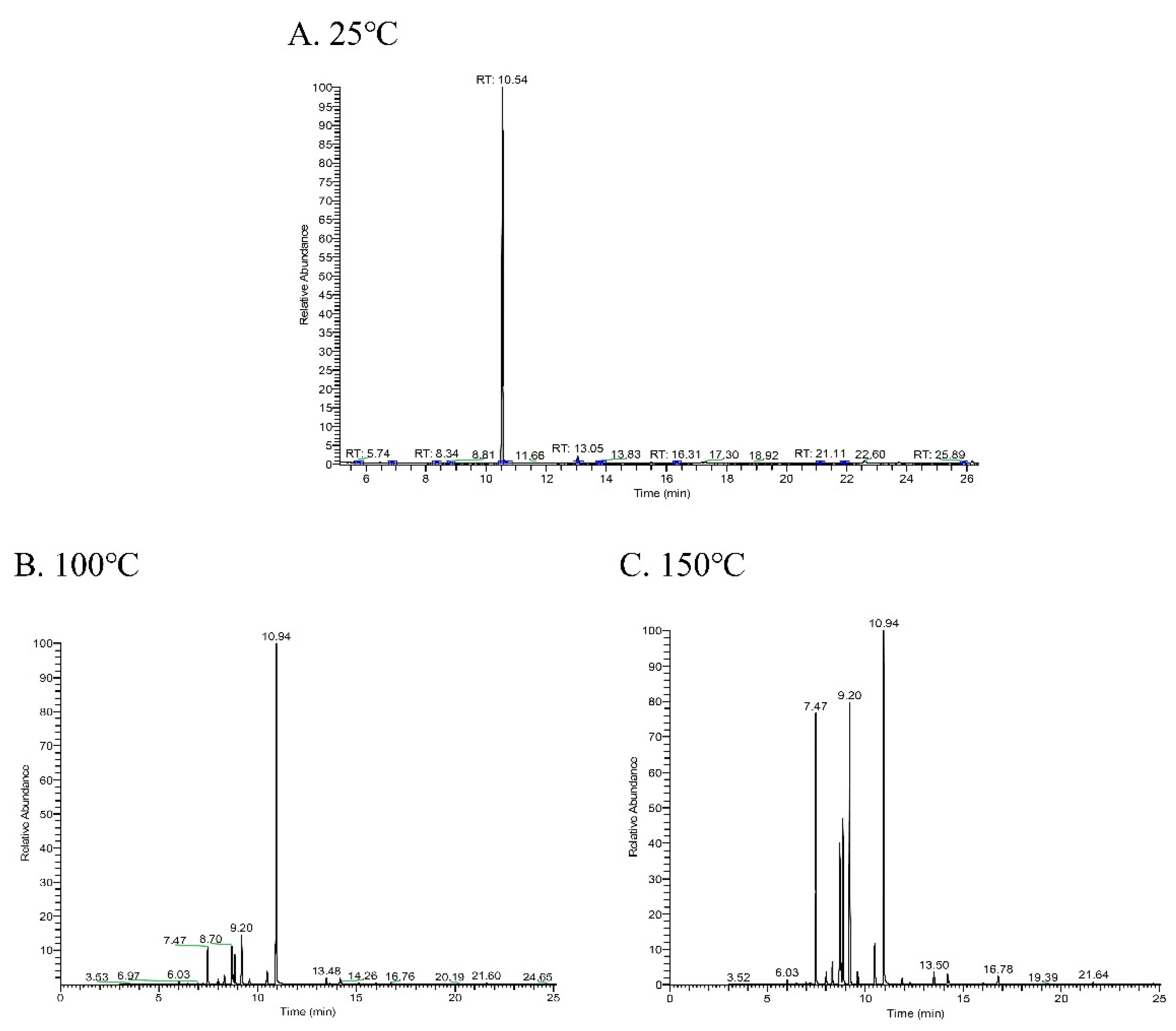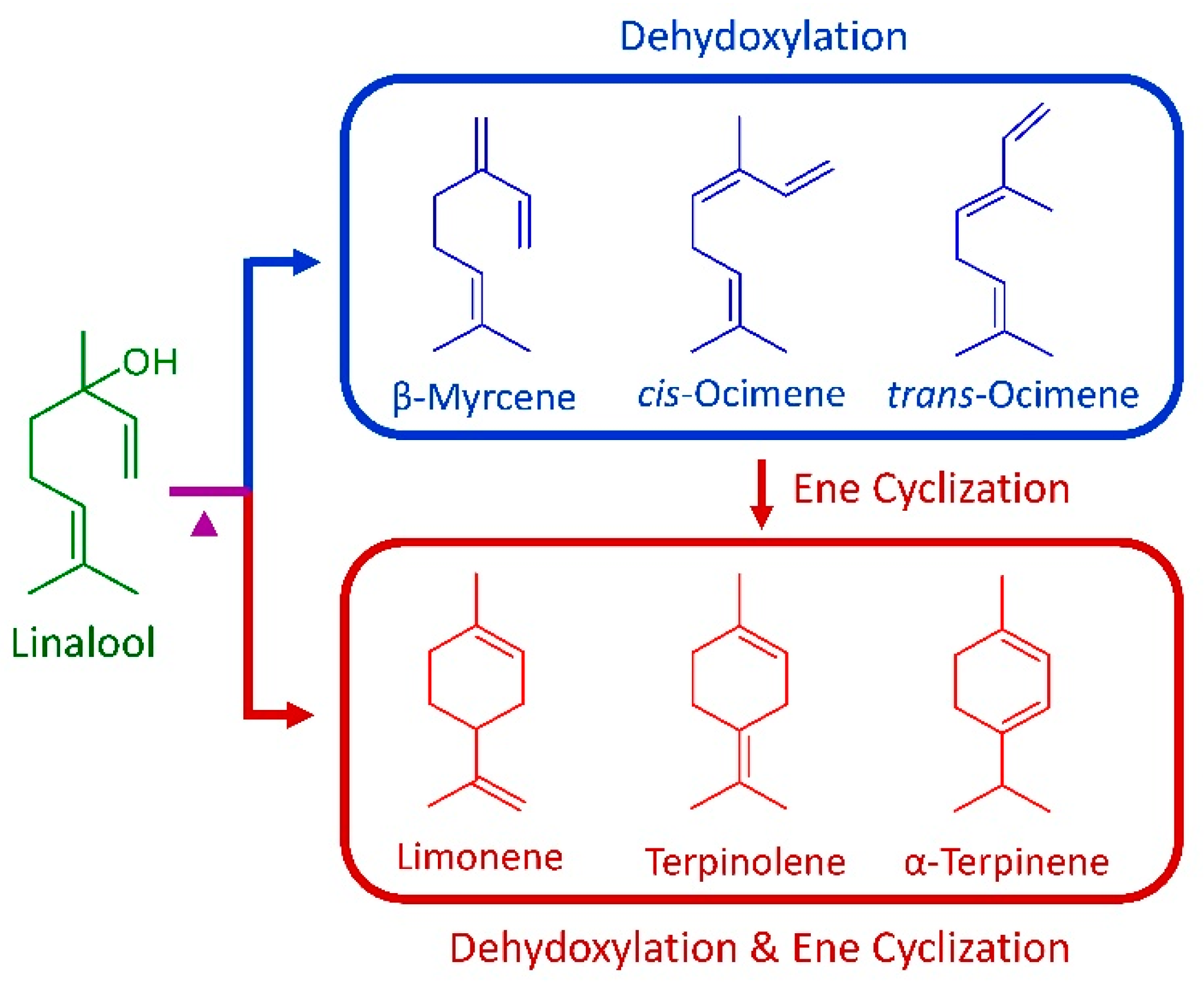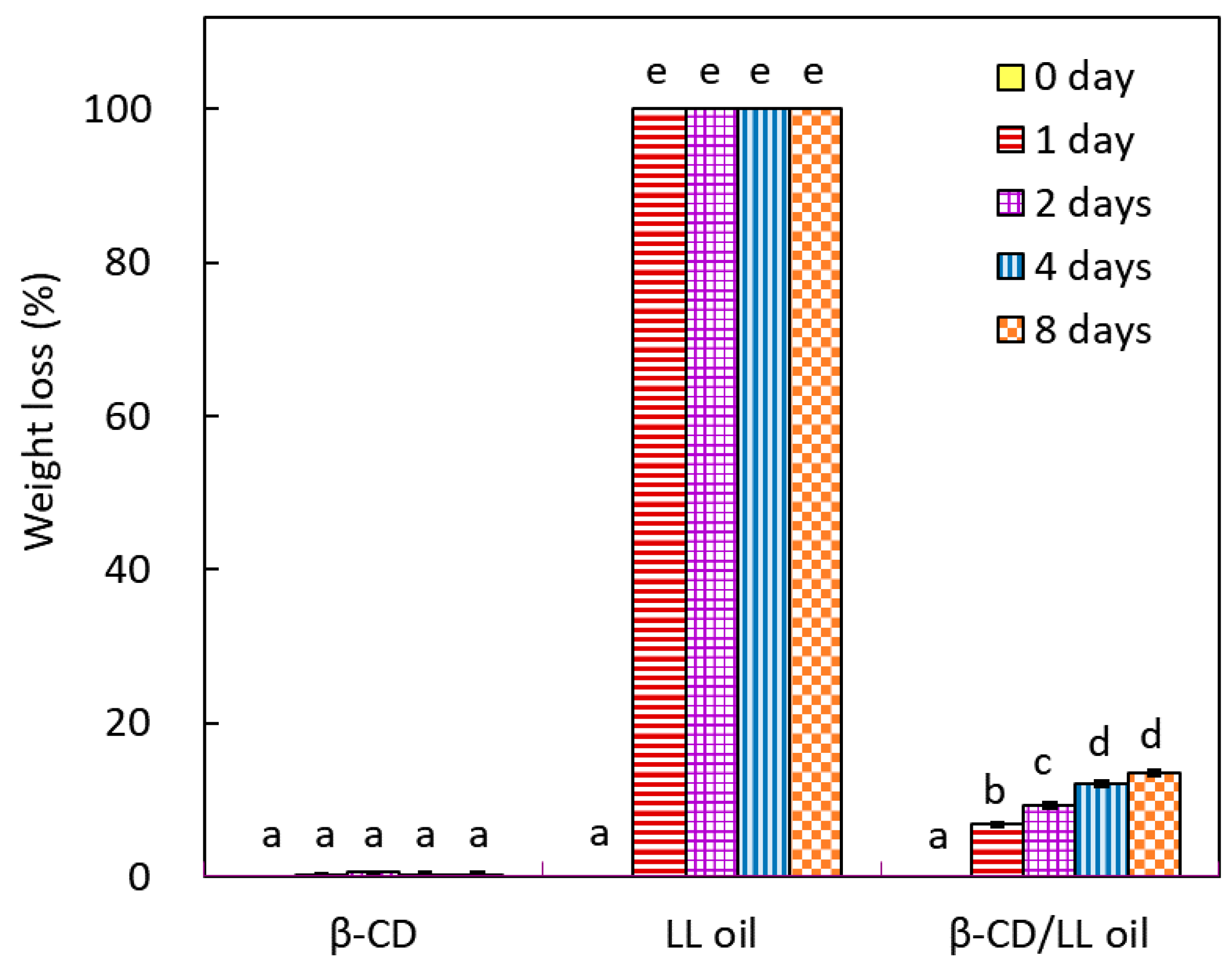Thermal Degradation of Linalool-Chemotype Cinnamomum osmophloeum Leaf Essential Oil and Its Stabilization by Microencapsulation with β-Cyclodextrin
Abstract
1. Introduction
2. Materials and Methods
2.1. Hydrodistillation
2.2. GC–MS Analysis
2.3. Microencapsulation
2.4. Accelerated Dry-Heat Aging Test
2.5. Statistical Analysis
3. Results and Discussion
3.1. Changes in Composition of C. osmophloeum Leaf Oil after Thermal Degradation
3.2. Optimization of Microencapsulation of Leaf Essential Oil with β-Cyclodextrin
3.3. Stabilization and Release of Leaf Essential Oil Microcapsules
4. Conclusions
Author Contributions
Funding
Data Availability Statement
Acknowledgments
Conflicts of Interest
Sample Availability
References
- Bandara, T.; Uluwaduge, I.; Jansz, E.R. Bioactivity of cinnamon with special emphasis on diabetes mellitus: A review. Int. J. Food Sci. Nutr. 2012, 63, 380–386. [Google Scholar] [CrossRef] [PubMed]
- Melgarejo-Flores, B.G.; Ortega-Ramirez, L.A.; Silva-Espinoza, B.A.; Gonzalez-Aguilar, G.A.; Miranda, M.R.A.; Ayala-Zavala, J.F. Antifungal protection and antioxidant enhancement of table grapes treated with emulsions, vapors, and coatings of cinnamon leaf oil. Postharvest Biol. Technol. 2013, 86, 321–328. [Google Scholar] [CrossRef]
- Rao, P.V.; Gan, S.H. Cinnamon: A multifaceted medicinal plant. Evid. Based Complement. Altern. Med. 2014, 2014, 642942. [Google Scholar] [CrossRef] [PubMed]
- Davaatseren, M.; Jo, Y.J.; Hong, G.P.; Hur, H.J.; Park, S.; Choi, M.J. Studies on the Anti-oxidative function of trans-cinnamaldehyde-included β-cyclodextrin complex. Molecules 2017, 21, 1644. [Google Scholar] [CrossRef] [PubMed]
- Kumar, S.; Kumari, R.; Mishra, S. Pharmacological properties and their medicinal uses of Cinnamomum: A review. J. Pharm. Pharmacol. 2019, 71, 1735–1761. [Google Scholar] [CrossRef]
- Wu, C.L.; Chang, H.T.; Hsui, Y.R.; Hsu, Y.W.; Liu, J.Y.; Wang, S.Y.; Chang, S.T. Antioxidant-enriched leaf water extracts of Cinnamomum osmophloeum from eleven provenances and their bioactive flavonoid glycosides. BioResources 2013, 5, 571–580. [Google Scholar] [CrossRef]
- Chang, S.T.; Chen, P.F.; Chang, S.C. Antibacterial activity of leaf essential oils and their constituents from Cinnamomum osmophloeum. J. Ethnopharmacol. 2001, 77, 123–127. [Google Scholar] [CrossRef]
- Cheng, B.H.; Sheen, L.Y.; Chang, S.T. Evaluation of anxiolytic potency of essential oil and S-(+)-linalool from Cinnamomum osmophloeum ct. linalool leaves in mice. J. Tradit. Complement. Med. 2015, 5, 27–34. [Google Scholar] [CrossRef][Green Version]
- Huang, C.Y.; Yeh, T.F.; Hsu, F.L.; Lin, C.Y.; Chang, S.T.; Chang, H.T. Xanthine oxidase inhibitory activity and thermostability of cinnamaldehyde-chemotype leaf oil of Cinnamomum osmophloeum microencapsulated with β-cyclodextrin. Molecules 2018, 23, 1107. [Google Scholar] [CrossRef]
- Kaiser, C.S.; Rompp, H.; Schmidt, P.C. Supercritical carbon dioxide extraction of chamomile flowers: Extraction efficiency, stability, and in-line inclusion of chamomile-carbon dioxide extract in β-cyclodextrin. Phytochem. Anal. 2004, 15, 249–256. [Google Scholar] [CrossRef]
- Wang, J.; Cao, Y.; Sun, B.; Wang, C. Physicochemical and release characterisation of garlic oil-β-cyclodextrin inclusion complexes. Food Chem. 2011, 127, 1680–1685. [Google Scholar] [CrossRef]
- Kfoury, M.; Auezova, L.; Greige-Gerges, H.; Larsen, K.L.; Fourmentin, S. Release studies of trans-anethole from β-cyclodextrin solid inclusion complexes by multiple headspace extraction. Carbohydr. Polym. 2016, 151, 1245–1250. [Google Scholar] [CrossRef] [PubMed]
- Pires, M.A.S.; Santos, R.A.S.; Sinisterra, R.D. Pharmaceutical composition of hydrochlorothiazide: β-cyclodextrin: Preparation by three different methods, physico-chemical characterization and in vivo diuretic activity evaluation. Molecules 2011, 16, 4482–4499. [Google Scholar] [CrossRef] [PubMed]
- Moya-Ortega, M.D.; Alvarez-Lorenzo, C.; Concheiro, A.; Loftsson, T. Cyclodextrin- based nanogels for pharmaceutical and biomedical applications. Int. J. Pharm. 2012, 428, 152–163. [Google Scholar] [CrossRef] [PubMed]
- Szente, L.; Szeman, J.; Sohajda, T. Analytical characterization of cyclodextrins: History, official methods and recommended new techniques. J. Pharm. Biomed. Anal. 2016, 130, 347–365. [Google Scholar] [CrossRef]
- Braga, S.S. Cyclodextrins: Emerging medicines of the new millennium. Biomolecules 2019, 9, 801. [Google Scholar] [CrossRef]
- Guimaraes, A.G.; Oliveira, M.A.; Alves, R.S.; Menezes, P.P.; Serafini, M.R.; Araujo, A.A.S.; Bezerra, D.P.; Quintans, L.J. Encapsulation of carvacrol, a monoterpene present in the essential oil of oregano, with β-cyclodextrin, improves the pharmacological response on cancer pain experimental protocols. Chem. Biol. Interact. 2015, 227, 69–76. [Google Scholar] [CrossRef]
- Nascimento, S.S.; Araujo, A.A.S.; Brito, R.G.; Serafini, M.R.; Menezes, P.P.; DeSantana, J.M.; Lucca, W.; Alves, P.B.; Blank, A.F.; Oliveira, R.C.M.; et al. Cyclodextrin-complexed Ocimum basilicum leaves essential oil increases fos protein expression in the central nervous system and produce an antihyperalgesic effect in animal models for fibromyalgia. Int. J. Mol. Sci. 2015, 16, 547–563. [Google Scholar] [CrossRef]
- Bomfim, L.M.; Menezes, L.R.; Rodrigues, A.C.; Dias, R.B.; Rocha, C.A.; Soares, M.B.; Neto, A.F.; Nascimento, M.P.; Campos, A.F.; Silva, L.C.; et al. Antitumour activity of the microencapsulation of Annona vepretorum essential oil. Basic Clin. Pharmacol. Toxicol. 2016, 118, 208–213. [Google Scholar] [CrossRef]
- Ibanez, M.D.; Sanchez-Ballester, N.M.; Blazquez, M.A. Encapsulated limonene: A pleasant lemon-like aroma with promising application in the agri-food industry. A review. Molecules 2020, 25, 2598. [Google Scholar] [CrossRef]
- Szejtli, J. Introduction and general overview of cyclodextrin chemistry. Chem. Rev. 1998, 98, 1743–1753. [Google Scholar] [CrossRef] [PubMed]
- Spada, G.; Gavini, E.; Cossu, M.; Rassu, G.; Carta, A.; Giunchedi, P. Evaluation of the effect of hydroxypropyl β-cyclodextrin on topical administration of milk thistle extract. Carbohydr. Polym. 2013, 92, 40–47. [Google Scholar] [CrossRef] [PubMed]
- Hill, L.E.; Gomes, C.; Taylor, T.M. Characterization of beta-cyclodextrin inclusion complexes containing essential oils (trans-cinnamaldehyde, eugenol, cinnamon bark, and clove bud extracts) for antimicrobial delivery applications. LWT-Food Sci. Technol. 2013, 51, 86–93. [Google Scholar] [CrossRef]
- Maes, C.; Bouquillon, S.; Fauconnier, M.L. Encapsulation of essential oils for the development of biosourced pesticides with controlled release: A review. Molecules 2019, 24, 2539. [Google Scholar] [CrossRef]
- Becerril, R.; Nerin, C.; Silva, F. Encapsulation systems for antimicrobial food packaging components: An update. Molecules 2020, 25, 1134. [Google Scholar] [CrossRef] [PubMed]
- Quintans, J.S.S.; Menezes, P.P.; Santos, M.R.V.; Bonjardim, L.R.; Almeida, J.R.G.S.; Gelain, D.P.; Araujo, A.A.S.; Quintans-Junior, L.J. Improvement of p-cymene antinociceptive and anti-inflammatory effects by inclusion in β-cyclodextrin. Phytomedicine 2013, 20, 436–440. [Google Scholar] [CrossRef] [PubMed]
- Jiang, S.; Li, J.N.; Jiang, Z.T. Inclusion reactions of β-cyclodextrin and its derivatives with cinnamaldehyde in Cinnamomum loureirii essential oil. Eur. Food. Res. Technol. 2010, 230, 543–550. [Google Scholar] [CrossRef]
- Ramos, A.G.B.; de Menezes, I.R.A.; da Silva, M.S.A.; Pessoa, R.T.; de Lacerda Neto, L.J.; Passos, F.R.S.; Coutinho, H.D.M.; Iriti, M.; Quintans-Junior, L.J. Antiedematogenic and anti-inflammatory activity of the monoterpene isopulegol and its β-cyclodextrin (β-CD) inclusion complex in animal inflammation models. Foods 2020, 9, 630. [Google Scholar] [CrossRef]
- Waleczek, K.J.; Marques, H.M.C.; Hempel, B.; Schmidt, P.C. Phase solubility studies of pure (2)-α-bisabolol and camomile essential oil with β-cyclodextrin. Eur. J. Pharm. Biopharm. 2003, 55, 247–251. [Google Scholar] [CrossRef]
- Iacovino, R.; Caso, J.V.; Rapuano, F.; Russo, A.; Isidori, M.; Lavorgna, M.; Gaetano Malgieri, G.; Isernia, C. Physicochemical characterization and cytotoxic activity evaluation of hydroxymethylferrocene: β-cyclodextrin inclusion complex. Molecules 2012, 17, 6056–6070. [Google Scholar] [CrossRef]
- Iacovino, R.; Rapuano, F.; Caso, J.V.; Russo, A.; Lavorgna, M.; Russo, C.; Isidori, M.; Russo, L.; Malgieri, G.; Isernia, C. β-Cyclodextrin inclusion complex to improve physicochemical properties of pipemidic acid: Characterization and bioactivity evaluation. Int. J. Mol. Sci. 2013, 14, 13022–13041. [Google Scholar] [CrossRef] [PubMed]
- Ciobanu, A.; Mallard, I.; Landy, D.; Brabie, G.; Nistor, D.; Fourmentin, S. Retention of aroma compounds from Mentha piperita essential oil by cyclodextrins and crosslinked cyclodextrin polymers. Food Chem. 2013, 138, 291–297. [Google Scholar] [CrossRef] [PubMed]
- Donato, C.D.; Lavorgna, M.; Fattorusso, R.; Isernia, C.; Isidori, M.; Malgieri, G.; Piscitelli, C.; Russo, C.; Russo, L.; Iacovino, R. Alpha- and beta-cyclodextrin inclusion complexes with 5-fluorouracil: Characterization and cytotoxic activity evaluation. Molecules 2016, 22, 1868. [Google Scholar] [CrossRef] [PubMed]
- Adams, R.P. Identification of Essential Oil Components by Gas Chromatography/Mass Spectrometry; Allured Publishing Corporation: Carol Stream, IL, USA, 2007; pp. 6–398. ISBN 978-1932633214. [Google Scholar]
- Ayala-Zavala, J.F.; Soto-Valdez, H.; Gonzalez-Leon, A.; Alvarez-Parrilla, E.; Martin-Belloso, O.; Gonzalez-Aguilar, G.A. Microencapsulation of cinnamon leaf (Cinnamomum zeylanicum) and garlic (Allium sativum) oils in β-cyclodextrin. J. Incl. Phenom. Macrocycl. Chem. 2008, 60, 359–368. [Google Scholar] [CrossRef]
- Liu, H.; Yang, G.; Tang, Y.; Cao, D.; Qi, T.; Qi, Y.; Fan, G. Physicochemical characterization and pharmacokinetics evaluation of β-caryophyllene/β-cyclodextrin inclusion complex. Int. J. Pharm. 2013, 450, 304–310. [Google Scholar] [CrossRef]
- Abarca, R.L.; Rodriguez, F.J.; Guarda, A.; Galotto, M.J.; Bruna, J.E. Characterization of beta-cyclodextrin inclusion complexes containing an essential oil component. Food Chem. 2016, 196, 968–975. [Google Scholar] [CrossRef]
- Leiner, J.; Stolle, A.; Ondruschka, B.; Netscher, T.; Bonrath, W. Thermal behavior of pinan-2-ol and linalool. Molecules 2013, 18, 8358–8375. [Google Scholar] [CrossRef]
- Trotta, F.; Zanetti, M.; Camino, G. Thermal degradation of cyclodextrins. Polym. Degrad. Stab. 2000, 69, 373–379. [Google Scholar] [CrossRef]



| Rt | KI | rKI | Constituent | Content (%) | ||
|---|---|---|---|---|---|---|
| (min) | Original | 100 °C | 150 °C | |||
| 6.03 | 938 | 939 | α-Pinene | 0.66 | 0.36 | 0.29 |
| 7.21 | 982 | 979 | β-Pinene | 0.28 | 0.07 | 0.06 |
| 7.47 | 991 | 990 | β-Myrcene | - | 5.56 | 17.89 |
| 8.01 | 1007 | 1002 | α-Phellandrene | - | 0.91 | 0.98 |
| 8.32 | 1017 | 1017 | α-Terpinene | - | 1.49 | 1.69 |
| 8.70 | 1027 | 1029 | Limonene | 0.61 | 7.77 | 11.40 |
| 8.86 | 1032 | 1037 | cis-Ocimene | - | 4.70 | 11.72 |
| 9.20 | 1049 | 1050 | trans-Ocimene | 0.32 | 7.94 | 20.08 |
| 9.60 | 1055 | 1059 | γ-Terpinene | - | 0.86 | 0.97 |
| 10.48 | 1082 | 1088 | Terpinolene | - | 2.53 | 3.37 |
| 10.94 | 1100 | 1096 | Linalool | 93.30 | 64.01 | 27.54 |
| 13.48 | 1180 | - | 2-Methylbenzofuran | 1.99 | 1.23 | 1.07 |
| 14.17 | 1186 | 1188 | α-Terpineol | 0.28 | 1.50 | 1.12 |
| 14.28 | 1198 | 1196 | Methyl chavicol | 0.57 | - | - |
| 16.80 | 1273 | 1270 | trans-Cinnamaldehyde | 0.52 | 0.15 | 0.74 |
| 21.64 | 1420 | 1424 | β-Caryophyllene | 0.59 | 0.22 | 0.17 |
| 22.42 | 1445 | 1446 | Cinnamyl acetate | 0.63 | 0.02 | - |
| Specimen | Specimen: β-CD (w/w) | EtOH: H2O (v/v) | Yield (%) |
|---|---|---|---|
| 0:100 | 1:2 | 0.0 ± 0.0 d* | |
| 5:95 | 1:2 | 54.3 ± 3.1 a* | |
| Linalool | 10:90 | 1:2 | 86.9 ± 0.2 b |
| 15:85 | 1:2 | 94.2 ± 0.4 c | |
| 20:80 | 1:2 | 91.0 ± 0.5 b,c | |
| 15:85 | 1:7 | 93.3 ± 0.6 B | |
| 15:85 | 1:5 | 98.1 ± 0.1 C | |
| Linalool | 15:85 | 1:3 | 97.0 ± 0.4 C |
| 15:85 | 1:2 | 94.2 ± 0.4 B | |
| 15:85 | 1:1 | 83.4 ± 1.8 A | |
| Leaf essential oil | 15:85 | 1:5 | 96.5 ± 0.2 |
Publisher’s Note: MDPI stays neutral with regard to jurisdictional claims in published maps and institutional affiliations. |
© 2021 by the authors. Licensee MDPI, Basel, Switzerland. This article is an open access article distributed under the terms and conditions of the Creative Commons Attribution (CC BY) license (http://creativecommons.org/licenses/by/4.0/).
Share and Cite
Chang, H.-T.; Lin, C.-Y.; Hsu, L.-S.; Chang, S.-T. Thermal Degradation of Linalool-Chemotype Cinnamomum osmophloeum Leaf Essential Oil and Its Stabilization by Microencapsulation with β-Cyclodextrin. Molecules 2021, 26, 409. https://doi.org/10.3390/molecules26020409
Chang H-T, Lin C-Y, Hsu L-S, Chang S-T. Thermal Degradation of Linalool-Chemotype Cinnamomum osmophloeum Leaf Essential Oil and Its Stabilization by Microencapsulation with β-Cyclodextrin. Molecules. 2021; 26(2):409. https://doi.org/10.3390/molecules26020409
Chicago/Turabian StyleChang, Hui-Ting, Chun-Ya Lin, Li-Sheng Hsu, and Shang-Tzen Chang. 2021. "Thermal Degradation of Linalool-Chemotype Cinnamomum osmophloeum Leaf Essential Oil and Its Stabilization by Microencapsulation with β-Cyclodextrin" Molecules 26, no. 2: 409. https://doi.org/10.3390/molecules26020409
APA StyleChang, H.-T., Lin, C.-Y., Hsu, L.-S., & Chang, S.-T. (2021). Thermal Degradation of Linalool-Chemotype Cinnamomum osmophloeum Leaf Essential Oil and Its Stabilization by Microencapsulation with β-Cyclodextrin. Molecules, 26(2), 409. https://doi.org/10.3390/molecules26020409







